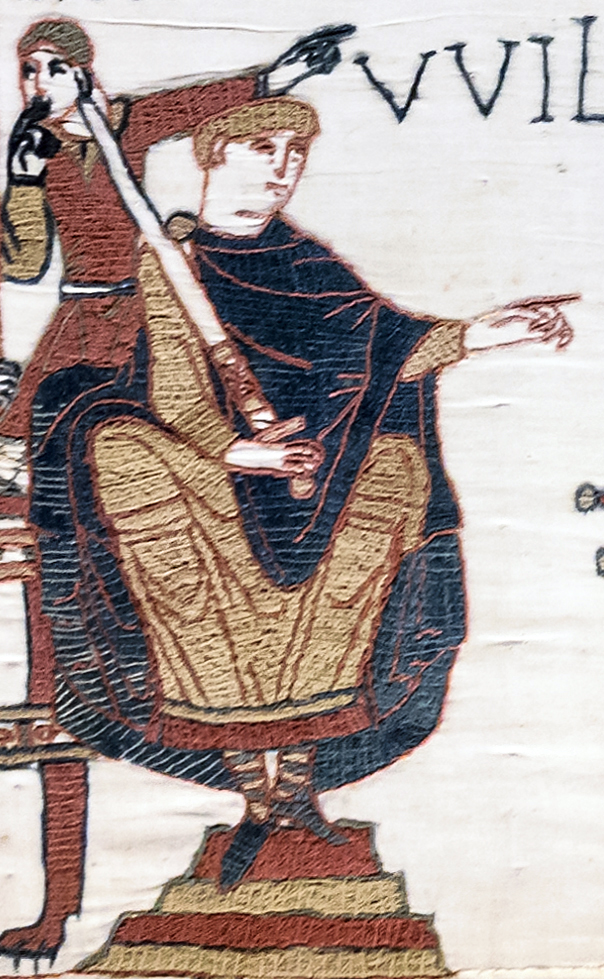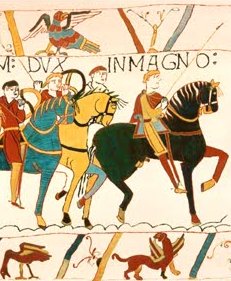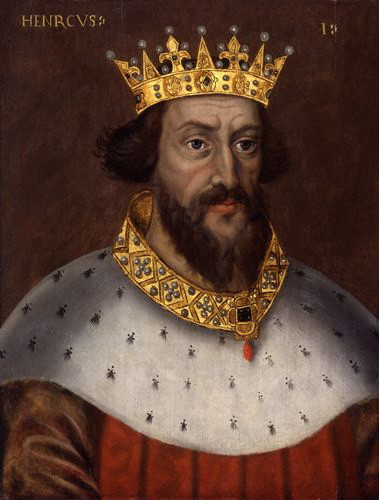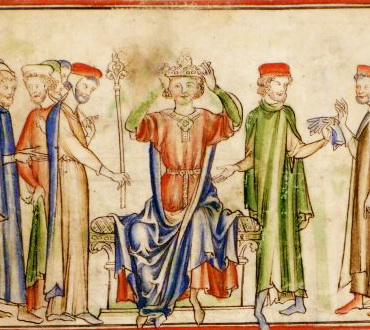1066 CE. The English Throne sits vacant after the King dies without an heir. Three claimants to the title quickly rise, and prepare to do battle over who would wear the crown. At the end of this turbulent year, invasions would be mounted, battles would be fought, and only one man would be left standing with the prize grasped in his bloody fist.
It is a tale that reads easier as fiction than fact, and in fact has been the inspiration for many famous fictional dynastic struggles, including Game of Thrones. This is the story of the victor of this struggle, who conquered a kingdom and changed the fate of a country and a continent. This is the story of William the Conqueror.

Early Life
Our story begins around 1000 CE. Viking raiders have been terrorizing the coasts of Europe for over 200 years. They took vast tracts of land by conquest, including the north coast of France by the English Channel, which eventually became known as the Duchy of Normandy. Further advances came on the British Isles, most notably in 1013, when the King of Denmark conquered England, and Danes ruled the country for 30 years before being driven out by the native Anglo-Saxons.
In these early feudal times, the central government, controlled by the King, was weak and decentralized, the land broken up into a series of earldoms, duchies, and baronies, ruled by an Earl, Duke, or Baron. These provincial leaders were, in theory, vassals of the King, and sworn to him by an oath of fealty, but in practice, they were very much autonomous, and struggles between the King and the provinces, and between the provinces themselves, were common.
William was born around 1028 CE, the illegitimate son of Robert I, Duke of Normandy. This led to his original nickname, usually used by his enemies: William the Bastard. His father seemed to have little interest in marrying any of his mistresses, which meant that William was considered the heir to the duchy from a very young age. In 1035, Robert embarked on a pilgrimage to Jerusalem, against the advice of his advisors. He made it to the holy city, but fell ill and died on the return journey, leaving William, at age 7, the Duke of Normandy.
As was typical when a child inherited a province or kingdom, there was great instability in Normandy as the region’s nobles and William’s relatives fought each other for control of the region and of the young Duke. A series of William’s guardians were killed, including one, Osbern, in the Duke’s bedchamber while he slept.
Things came to a head in 1047, when Guy of Burgundy rose in rebellion against the ducal government, supported by other nobles. They attempted to capture Duke William at Valognes, had they succeeded, he almost certainly would have been killed. But William escaped and fled south to Paris, seeking refuge with King Henry I. William soon returned, however, at the head of an army, and together with the forces of King Henry, they defeated the rebels at the Battle of Val-es-Dunes. At age 18, Duke William was already showing himself to be a capable soldier and commander.
The rebellion of 1047 was not to be the end of Normandy’s internal strife. William continued to deal with rebellious nobles until 1054. At this point, alarmed by the consolidation of power under William, King Henry turned against his vassal and led an army into Normandy. But he was soundly defeated by William’s forces and chased out of the duchy. He tried again in 1057, and was defeated again. This enmity continued until King Henry’s death in 1060.

English Concerns
By 1060, William had largely taken control of Normandy and put down internal opposition to him. With the death of King Henry, his 7 year old son Phillip was named king, but was too young to rule. One of the regents appointed to rule the kingdom during Phillip’s minority was William’s father in law, Baldwin V, Count of Flanders, so there would be no more trouble from the crown for the time being. So William turned his focus towards expansion.
The Duke acquired some territory on the Continent, such as the County of Maine, and fought a campaign in Brittany, but his keenest interest lay to the north, across the Channel, to England. It was becoming increasingly apparent to everyone that King Edward the Confessor would die without producing an heir to his throne, leaving a power vacuum that various factions would rush to fill.
The most logical internal candidate to succeed Edward was Harold Godwinson, the Earl of Essex. Harold was a leading member of the Godwin family, the most powerful nobles in the kingdom. He was also Edward’s brother-in-law.
However, Duke William also felt he had a legitimate claim to the throne. At one point, in 1051, the Godwins fell out of favor with King Edward and were exiled. It’s believed that the King reached out to William at this point and named him his heir: Edward had lived in Normandy for 30 years after his father was deposed by the Danes, protected by the Dukes of Normandy, so the connection made sense. However, a year later, the Godwins returned to England and reconciled with Edward, thus leaving the question of the succession extremely murky.
Some historical sources tell us that Harold Godwinson traveled to Normandy around 1064, and met with Duke William. It’s said that he swore an oath during that meeting to uphold William’s claim to the throne of England. However, the only sources that document this are Norman, and there’s no way to know if this actually took place or was Norman propaganda.
The Game Begins
King Edward the Confessor died January 5th, 1066. On his deathbed, he named Harold Godwinson as his heir. Harold acted quickly, crowning himself king the next day and quickly gaining the support of the English nobility. Across the Channel in Normandy, Duke William was furious. He knew at this point that the only way to uphold his claim to the throne would be to take it by force. He vowed to raise an army and invade England.

This ambition was hardly secret, and all of Europe watched and waited throughout the spring and summer of 1066 as William prepared his invasion force. Harold, of course, heard of William’s plan, and raised an army of his own to counter the threat of a Norman invasion. He spent most of the summer in the south of England waiting for Duke William to make his move.
However, most of Harold’s force was composed of civilian militia levees that needed to return to their fields to harvest their crops, and the king was forced to dismiss a large part of his army on September 8th. And to make matters worse, around the same time, Harold learned that another claimant to the throne had appeared.
The Norsemen Attack
A year before the events of 1066, Harold Godwinson’s brother Tostig had been stripped of his earldom of Northumbria and driven into exile. Infuriated by what he saw as his brother’s betrayal, he went to the King of Norway, Harald Hardrada, and convinced him to make a claim for the English throne and invade from the north of the country. Harald believed he had a legitimate claim to the throne of England because he was descended from the line of Vikings that had conquered and ruled England for thirty years before Edward the Confessor took over.
Harald also spent the summer of 1066 making preparations for his invasion, and left Norway at the end of August with a fleet of 300 ships and an army of 15,000 men. He landed in England in early September, and met up with Tostig. Together they attacked towns and villages throughout Northumbria, and defeated an English army led by the local lords. This prompted the surrender of the great city of the north, York.
In the south, Harold learned of the Norweigan invasion, and quickly turned north with as many soldiers as he could muster. He made the 185 mile trip north in only 4 days, riding day and night.
On September 25th, 1066, the Norse army left their encampment and marched to Stamford Bridge, where they expected to meet with representatives of the city of York to receive hostages and supplies. Not expecting a fight, they left most of their heavy armor back at the camp. Imagine their surprise then, when they arrived to find not cowed townspeople, but the English royal army waiting for them.
Alarmed, Harald Hardrada and Tostig Godwinson rode forward to meet their enemy. King Harold approached them, alone. He spoke to his brother, offering him his earldom back if he turned against Hardrada and sided with him. Tostig asked what Harold would offer Hardrada for his trouble.

“Seven feet of English ground, for he is taller than other men,” Harold replied coolly. There could be no negotiating with rival claimants to the throne of England. And Tostig refused to switch sides. The Battle of Stamford Bridge was on.
The Norwegians began to retreat across the bridge, a stronger position waiting for them on the other side as the English attacked. Harold’s army was held up on the bridge by a single Norse soldier, a berserker armed with a two handed great axe. He killed 40 men single handedly before he was finally killed by an English soldier who floated under the bridge and stabbed him from beneath.
The English rushed across the bridge, meeting the shield wall of the Norse. The battle was furious. At some point, Harald Hardrada was mortally wounded by an arrow, and Tostig Godwinson was slain on the field. The lack of heavy armor on the part of the Norse made the difference, and their army was cut to pieces. Once the English broke through the Norse shield wall, the battle became a slaughter. By the time it was over, 10,000 were dead. Harold allowed the survivors to return to Norway peacefully. So many had died that only 25 of the original 300 ships were needed to transport them back. Never again would a Scandinavian army threaten England. The Age of the Vikings was over.
But Harold didn’t have time to celebrate his victory. Instead, he immediately turned around and marched south again. Because he knew Duke William was coming.
The Norman Invasion
Just three days after the Battle of Stamford Bridge, on September 28th, the Norman army landed at Pevensey Bay on the south coast of England. Like Harold, William didn’t know of the Norwegian invasion, but it worked out nicely for him because it allowed him to land unopposed. The Duke moved his forces to the nearby town of Hastings, where he built a wooden castle. There he was content to wait, close to his supply lines via the sea, for Harold to come to him.
Harold heard of William’s invasion while he was marching south, but proceeded more slowly than he had when responding to the Norwegian invasion: his army was still recovering from the Battle of Stamford Bridge, and he had to leave a large part of it in the north. Even still, he probably moved TOO quickly, had he waited a few more days, he likely would have had more men at his disposal to face the Normans.
As it was, Harold’s army encamped at the top of a steep slope on the night of October 13th, a few miles north of William’s fortified camp at Hastings. His efforts to surprise William failed, and the Normans knew he was coming.
The morning of October 14th dawned unusually bright and warm for October in England. Duke William’s Norman army left its camp and marched to where the English were. William hoped to settle the question of who should rule England with a single decisive battle. Whoever won was clearly ordained by God to sit on the throne, he believed.
The Battle of Hastings
The English army was almost entirely composed of infantry, with no cavalry and few if any archers. With this in mind, Harold kept his forces on top of the hill, having his front rank lock shields into an impenetrable wall that would fend off the Norman infantry and cavalry attacks, and blunt the effect of the Norman archers.
And that’s exactly what happened during the early stages of the battle. Repeated charges by the Norman cavalry were repulsed, and the Norman infantry were unable to break through the shield wall. The French archers were hampered by the steep slope, firing either directly into the shield wall, or over the heads of the English.
Then, the first decisive moment of the day: the left flank of the Norman army suddenly broke and ran in a panicked flight. A rumor had spread through the ranks that Duke William had been killed, and the Normans wanted no part in continuing the battle without their leader. Even though Harold ordered his army to remain on the hill, some disobeyed and chased the fleeing Normans.
William was not dead, and he rode through the ranks of the fleeing soldiers, removing his helmet to show them that he was still in the fight. He managed to turn them around and attack the pursuing English. Outside the protection of the shield wall, the English took heavy casualties.
A lull settled over the battlefield as the soldiers from both armies rested. The retreat of his left flank had given William a new idea: if he had portions of his army pretend to retreat, he could provoke the English to follow, and engage them off the hill and without the shield wall. When the battle recommenced, it’s believed he did this at least twice, with moderate success.
The English were taking casualties, but the line held. The issue was still very much in doubt as afternoon turned into evening. Soon darkness would make further fighting difficult, if not impossible. Just as it seemed nothing would be settled that day after all, catastrophe suddenly struck the English. King Harold was hit in the eye with an arrow, going into his brain. He fell from his horse, killed instantly.

Without their king, the English army was leaderless, and quickly fell apart. The Normans pursued the fleeing English for a while, but were stopped by darkness. It didn’t matter: the Battle of Hastings was over, and there was only one claimant to the English throne left standing.
King William
Despite his victory and the death of Harold, the English still resisted the Norman invasion for another two months, forcing William to take the city of London by siege. But soon enough, it was over, and on Christmas Day 1066, William was crowned as the King of England.
It took another five years for William to pacify his new realm, as he dealt with a series of rebellions by the Anglo-Saxon aristocracy. William dealt with this by building a series of castles throughout England, giving them to his supporters to keep order over the land. By the time William died, England was dotted with over 500 castles. The most famous fortress that William built was the White Tower in London, which eventually became the central keep of the Tower of London.
One of William’s key problems was his inability to be in two places at once: when he was in England, there were uprisings in Normandy. And when he was in Normandy, there were rebellions in England. William spent most of the first ten years of his reign travelling between the two countries, dealing with rebels, while also gradually transforming English life. Over time, most of the Anglo-Saxon nobles had been replaced by Normans, and the ones who were left began to marry into Norman and other French families. Official documents were written in Latin or French instead of Old English.
Two works enhance our modern understanding of this period. The first is the Bayeux Tapestry, an incredible 230 foot long piece of embroidered cloth commissioned by William’s brother Odo shortly after the Battle of Hastings. The tapestry depicts the events of 1066 from the Norman side, from King Edward’s death to the victory of the Normans at the Battle of Hastings. Incredibly, this tapestry has survived intact for over 900 years and can still be seen today at a dedicated museum in Bayeux.
The second work was commissioned by King William in December 1085. He wanted a complete record of all the royal holdings in England, a record that came to be called “The Domesday Book”. This book documented all the lands of the English realm in great detail, including who had controlled the land before the Conquest, how much tax revenue the area produced, the number of people who lived there, even absurdly specific details such as how many chickens a particular farmer had, or how much milk a dairy farm had produced in a given year. This record, preserved in the National Archives in London, offers us great insight on the disposition and administration of England during the time of the Norman conquest.
Final Days
In 1087, William returned to Normandy to deal with his eldest son Robert, who was allied with the King of France in an attempt to undermine him. While engaged in this campaign, William was injured by the pommel of his saddle, and the wound grew infected. He was taken to Rouen where his condition quickly deteriorated.
William knew he needed to settle his affairs. He left Robert the duchy of Normandy and his second son William was given control of England. Once it became clear that the king was going to die, his advisors and courtiers all left him to settle their own affairs. As a result, William died completely alone on September 9th, 1087, aged 59.
In the immediate aftermath of the king’s death, his sons Robert, William, and Henry all fought each other over control of the kingdom. Normandy itself eventually became formally a part of the Kingdom of France, and the heritage of the Vikings was swept away.
The course of English history, meanwhile, was changed significantly by the events of the Norman conquest. Prior to the conquest, England had more closely identified culturally with Scandinavia than with continental Europe. Afterwards, England was brought closer to France, ties which bound it into the Middle Ages and caused a centuries-long rivalry between the two countries.
The story of the Norman conquest is one of the most famous in world history. It was a momentous event that shaped the course of European history for centuries to come. And it bestowed upon William I, King of England and Duke of Normandy, a new title, one that no one is likely to forget: William the Conqueror.



